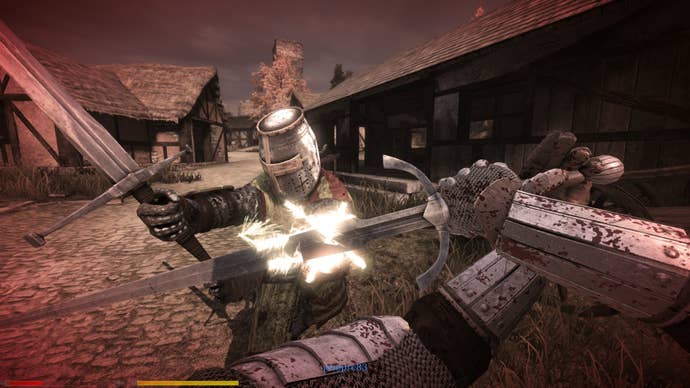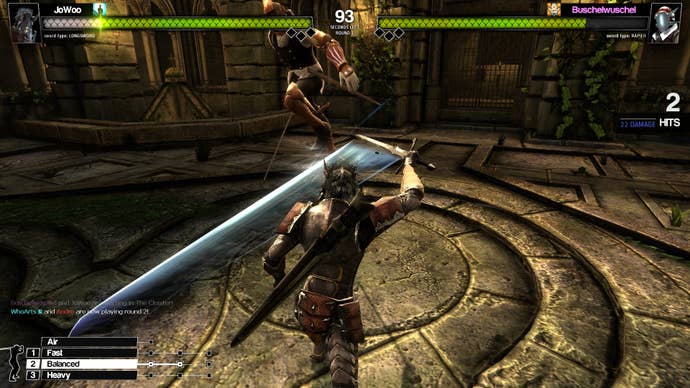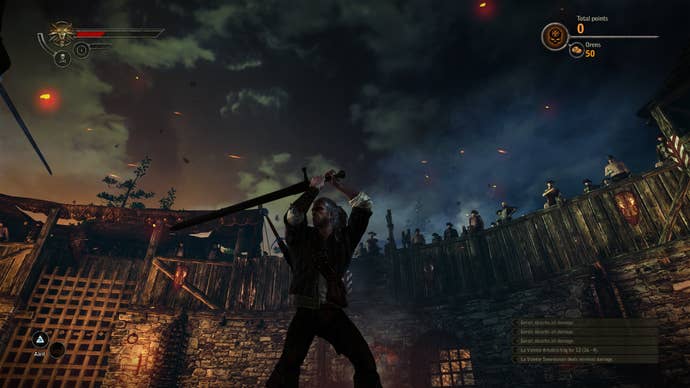Developing by the Sword
Eurogamer's Rick Lane explores the challenge of creating authentic and entertaining melee combat systems in games.
This article first appeared on USgamer, a partner publication of VG247. Some content, such as this article, has been migrated to VG247 for posterity after USgamer's closure - but it has not been edited or further vetted by the VG247 team.
The virtual gun is so often at the forefront of gaming discussion.
For 20 years it has been the weapon of choice for the majority of both games and players. It's the first thing we see when developers show off their latest graphics engines, and there's always one at hand when a violence controversy springs up in politics or the mainstream media.
There's no secret behind the gun's ubiquitous nature. Its action can be replicated with relative ease using gamepads and the keyboard and mouse alike, and as Simon Parkin put it in his look back at Portal "There is no tool better suited to giving players the ability to affect objects both near and far in a 3D world, extending the player's reach into the television screen." Such is the gun's elementary effectiveness that over the course of two decades its representation has barely changed at all.
The virtual sword, on the other hand, has followed a very different path. It's been around as long as the gun has, but concealed among the dice-rolls and narrative threads of fantasy RPGs, and as one choice of many in the hack 'n' slash genre. Occasionally it will see a game dedicated towards it, but usually it only plays a bit-part, a supporting role.
The reason for this is simple; creating an authentic and yet entertaining swordfighting game is incredibly hard. Over the last few years I've become increasingly fascinated by the portrayal of swordfighting in games, which ultimately led me to join a historical fencing society and learn how to do it for real. The discrepancy between how actual swordfighting plays out and how it is portrayed in games (or indeed any fiction) is striking. But examine the situation from the developer perspective and you quickly realise why this is.

Unlike an FPS, where the input controls give a fairly accurate representation of the action involved when aiming and firing a gun, they bear no resemblance whatsoever to the full-body movements involved in swordplay. Even motion controls can't currently replicate things like the point at which two swords clash.
In addition, whereas a gun fires a bullet in a straight(ish) line, a sword strike can come from any direction. You can attack from the sides, from overhead, across the diagonal, and even from below. You can cut or stab, or attack using the crossguard or pommel. There are different guards, different techniques, and even different styles. To give one example of the nuances of real swordplay, in medieval longsword there's no such thing as a parry. The length of the blade means every strike is designed to both defend the wielder's body and kill their opponent at the same time.
Replicating such intricacy in pixel form without the game taking literally years to learn would be impossible. But this doesn't mean games have to be restricted to single input melee combat systems that are all style over substance, as is the case with many mainstream titles like Assassin's Creed or Ryse: Son of Rome. There are ways of making virtual swordfights engaging, entertaining, and to a certain extent, authentic. What's more, a growing number of developers are exploring methods of doing this.
One such developer is Torn Banner, the creators of the multiplayer duelling game Chivalry: Medieval Warfare. Rather than forcing players to watch their avatar perform cool tricks, Chivalry puts you in the thick of the action, ensuring the player is in control as much as possible, and it does this by abstracting the notion that swordfighting is an action that uses the entire body. "One of the phrases that we like to use when we try to explain our complex system is that WASD keys are your feet, and your mouse is your hips," says Steve Piggott, President of Torn Banner. "With Chivalry's combat system you can actually turn into your strikes, and land sooner or later depending on how you're turning your hips. So that's kind of simulating that snapping motion you get when you're turning into your strikes in real-life."
Attacks in Chivalry are split into three types, a horizontal swipe, an overhead slash, and a forward thrust. But abstract replication of full-body-movements through the mouse allows for some additional nuance in your swings. Torn Banner's approach to melee combat is broadly empirical, striking a balance between what looks and feels good. Not just for the attacker, but for the defender as well. "We came across certain things, such as the ability to hold your attacks forever. That felt really good to the player who was using them, but on the other side of that when someone's doing that to you, that was a really confusing experience a lot of the times in multiplayer, because you had no indication of when someone was coming down."

This is an area where virtual swordplay must by necessity differ from the real thing. Swordfighting is fast, and if you don't respond to an attack in the right way, bad things are going to happen to you. To stay loyal to that speed simply wouldn't be enjoyable in an online environment when the attack can come from any direction. Attacks need to be slower and more obvious in order that the defending player has a chance to block them.
But this in turn leads to another conundrum. How exactly should blocking work? Some games, simply require you to hold down a button. For Chivalry, the team opted for a timed block, where -- provided you're facing the right direction and pressing the block button within a certain window of the opponent's swing - the attack will be blocked. "We didn't want to lock the players movement into his blocking direction," Piggott points out. "What we ended up doing was having a system that uses directional, but you don't lock into that direction. It's just like aiming in an FPS."
Although Chivalry is a good example of how to build a melee combat system, it isn't perfect. Chivalry has a wide array of weapons, but they're all used in broadly the same fashion (with the exception of ranged weapons like longbows) with no significant differences in style between them. It's also by no means the only way to develop a melee combat game. Chivalry's basis is medieval history, and so its combat is grounded in some sense of authenticity. But this needn't be the case. Indeed, one of the best melee combat games in existence is Jedi Knight 2. Its multiplayer duels have become stuff of legend, and it has zero grounding in reality whatsoever.
Michael Chang was one of those enthralled by Jedi Knight 2's duelling mode, so much so that, with his development team at Puny Human Games, he has created a spiritual successor to the game in the form of Blade Symphony. It's a game that takes the essence of Jedi Knight 2's acrobatic combat, and translates it into a new world where various types of martial artists compete against one another.
"Our design concern wasn't ever really about authentic representation. It just had to make internally-consistent sense, that left+attack equates to an attack that starts from your right and ends to your left, and having that play out in time and space is important," Chang explains. "That was what made the difference between Skyrim-style melee attacks and how a sword should behave in three dimensional space, the fact that you can direct this weapon at many angles around yourself, and have that be meaningful."

Blade Symphony differs from Chivalry in a lot of ways, ostensibly breaking many of the rules Chivalry uses to make itself entertaining. Blade Symphony's more acrobatic, fantastical combat means there are a lot of flashy animations, which on the surface are precisely what you don't want in a good melee combat game. But there's one important difference between Blade Symphony and, say, Assassin's Creed. "One key decision we made was allowing the player to direct this motion once it has begun, so even for the long two-second attacks, the player can still drive the animation in the way they want to by looking a certain way, and even aim the sword up and down to gain some control."
Another divergence in design between the two is that Chivalry's weapons only become "active" when the player attacks, whereas in Blade Symphony the blades are constantly active. In other words, the swords are always sharp. Again, this is an idea adopted from Jedi Knight 2, although it wasn't added until late in development. "I threw it in there to experiment with a 'multi-hit' damage model, and it felt way more analogue, more granular," Chang explains. "Suddenly the quality of the attack mattered. How much did you turn during your attack to maximize damage? How close were you when you struck? Did your aim falter after that stab attack, or did you keep it firmly in your opponent?"
The differences between Blade Symphony's approach to melee combat and Chivalry's gives an indication as to why these games are so difficult to make. There's simply no established framework for developing a melee combat game. Compounding this problem is the fact that there's no set rulebook for teaching real swordfighting techniques either. Much of the knowledge regarding the specific practice of Western martial arts has been lost in time, and the few instructive sources that remain are written in medieval variants of languages like German and Italian. Hence they require extensive translation and interpretation. So even if you tried to represent melee combat authentically in your game, there's no guarantee that the techniques you based it on will be correct.
What Chivalry and Blade Symphony do share in common, though, is that they are games that are dedicated almost entirely to the art of hitting another person with a big metal stick, and this isn't how players normally experience melee combat in games. More often than not, it's part of a much larger game, usually RPGs. Given these tend to be enormous games anyway, this limits what the developer can do before they've even started.
There is one RPG developer who is attempting to make their melee combat more engaging than simply clicking on a monster until it falls over. CD Projekt's Witcher games have evolved from an obscure RPG created by an unknown developer into one of the most respected series in the industry, and the game's combat system has evolved alongside it. In the first game, Geralt's fighting mechanics were a very simplistic, almost rhythm action affair of clicking in time with prompts on screen. While it certainly had flair, it wasn't exactly engaging.
"We got a lot of mixed feedback," says Andrzej Kwiatkowski, gameplay designer on the Witcher 3. "On one hand, some gamers loved it, on the other, it was not exactly 'it'. Rather than iterating on something that may have ended up as being a one way street, we decided to come up with a system that was more flexible and had more potential."
The Witcher 2's combat system was a lot more involved; entirely real-time with different types of attack, special moves, dodges, blocks and so forth. It was also based to a certain extent on historical techniques. Geralt's blocking stance when using his steel longsword, for example, is a real guard known in the German school as 'Ochs' (Ox), where the sword is held above the head with the blade pointing at the enemy, like the horns of an Ox. "We work with people that know the period in and out." Kwiatkowski says "There's also a ton of people in the company that do sword fighting and treat it as a hobby."

Although The Witcher 2's combat was definitely more interesting, it was also problematic. It looked and felt great when against a single opponent, but when facing multiple enemies it tended to devolve into Geralt rolling around on the floor like an overexcited child. Meanwhile, later on in the game, the combat became dominated by QTEs that took much of the control away from the player. Eventually this was rectified to a certain extent by the combat rebalance mod, created by Kwiatkowski himself. "A lot of the philosophy from the mod is also present in The Witcher 3," he points out.
The Witcher 3's combat will see more changes than simple rebalancing. Geralt's frantic acrobatics witnessed in the second game are being replaced by a slower and more deliberate move-set. "He's not running around his enemies, he thrusts with well aimed strikes and delivers deadly blows more efficiently. It's definitely not hack and slash." Kwiatkowski also states that the combat system will be complemented by over one hundred new animations, and that QTE's have been removed from the game entirely.
CD Projekt's seven-year struggle to create an authentic, engaging and yet easy to pick up melee combat system in an RPG demonstrates just how difficult the job is, and it will be interesting to see how their third attempt turns out. Perhaps they will create something that finally sets a standard for the RPG genre, and indeed melee combat games as a whole.
In truth, this is unlikely, and I don't believe it would be a good thing. Developers might have only just begun to understand that there might be better modes of representing melee combat in games. But that lack of an established template also means every game is different in the way it moves, the way it controls, and the way it feels. Where 20 years of doing the same thing has resulted in the gun increasingly falling out of favor, with the sword there are only interpretations and possibilities, and that is very exciting indeed.








